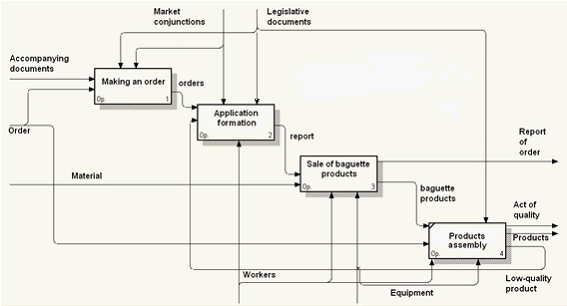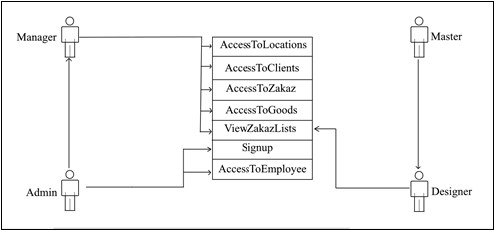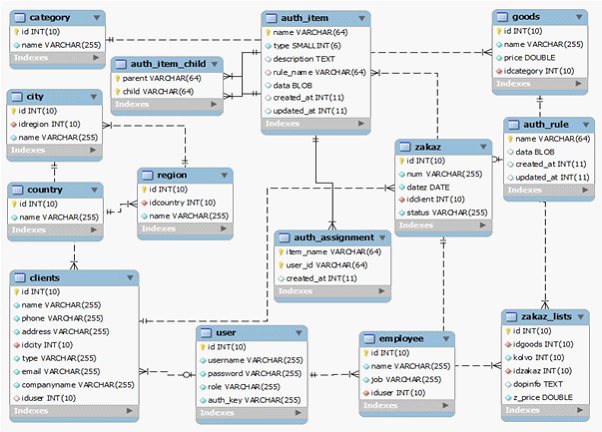Abstract
This paper discusses the implementation of system modelling and analysis standards in teaching technical disciplines using application programming elements in high-level development environments. In the course of education, students consistently study the software development lifecycle stages and face the problems of updating the terms of reference from municipal and private customers at the design stage of relational databases and client applications. The author showed using the IDEF0, IDEF3, and DFD standards to identify the main requirements for software implementation notations. The software development included the following stages: the official customer's query to fulfill a technical task, the subject area analysis of the customer's business and his requirements for the application development, the design of the database and application interface. Verification of the development process was carried out at the bachelor's degree courses "Information systems and technologies at enterprises" of Sholom-Aleichem Priamursky State University during the discipline "Tools," "Systems Theory and Structural Analysis," "Mobile Application Development," and "Software Engineering." Students studied the customer's business processes presented by individual entrepreneur Mishukova N.A., designed the database structure of the unique baguette products, and the interaction of screen forms of client applications based on the II2 framework provided high ergonomics of systems. Students actively discussed the issues of web resources integration and network databases, together with applications development in Windows and Android multi-platform operating environments.
Keywords: Education process, higher education institution, information system, modelling, system analysis
Introduction
In modern higher education, it is essential to analyze the original ideas of developing information systems on the part of students, which allow expressing their organizational skills at the initial stage of the graduates' professional activity (Redko et al., 2019). The ability to anticipate the complexities of designing and developing multi-platform systems in difficult socio-economic conditions necessitates the formation of mobile data processing tools and results presentation, together with their operational and analytical promotion to potential users.
Problem Statement
It is generally assumed that most of the system analysis and modelling tools used in the learning process correlate with the object-oriented systems and education information standards tools. However, they include information system development environments and a description of functional data tasks. They allow fully mastering all stages of the life cycle of implementing a client application (domain analysis, design, development, testing, and maintenance) to a database according to modern standards (Laporte et al., 2017).
Research Questions
In the research, we solved the issues of using system analysis and modelling in Russia compared to the international experience of teaching technical disciplines. Students built the life cycle of information systems, designed external forms of client applications, modelled application data flows and user's actions together with evaluating the effectiveness of SADT modelling (Gonçalves et al., 2017).
Purpose of the Studу
By the subject organization of the relationship between the participants of the education process, we will understand a set of interrelated software and hardware tools for a complete analysis of the subject area in the form of functional units. The atomic components of the stages of the socio-economic process and scientific modelling act as the development trigger of the organization.
Research Methods
In carrying out this analysis, we used the following methods: logical and didactic analysis, the construction of a client application interface, the study of technical documentation of multi-platform client application development environments, existing experience in using information technologies in technical disciplines, and comparative analysis.
Findings
It is necessary to use system-activity concepts, which allow us to determine students' professional success upon graduation from a higher educational institution when forming scientific modelling according to information and education standards. System modelling and analysis allow us to reveal the objects' unique properties, considering the interactions between the system behavior and the factors affecting the change in input data. In this case, the presence of information flows and functional blocks of the system, such as mechanisms and management, is determined. System modelling makes it possible to find solutions using identifying descriptive schemes, and form an algorithm and concretize its development in the Spatio-temporal aspect. The current methodology use of the SADT structural approach (Elhaddouchi & Elkharraz, 2020; Gómez-Zepeda et al., 2017) is a principal tool for solving production tasks, and it motivates students to solve the information system customer's functional tasks. Due to the limited knowledge, students need to fully reflect on the subject area under the study to achieve a high level of abstraction in the customer's business processes representation with the transfer to the components of the future information system.
The use of system modelling and analysis tools as a means of supporting the education process seems to be quite relevant and appropriate for detailed specification of the technical task for software development.
The testing of the client application design was carried out during the classes under the specialty "Information Systems and Technologies at Enterprises." During the study, the stages of the life cycle of the technology of accelerated development of RAD (Safiudin et al., 2020) were considered, including the structure and business processes of activities analysis, database design, and applications for the manufacture of unique baguette products of the customer IP Mishukova N. A. in the city of Birobidzhan of the Jewish Autonomous Region. The customer's business process is considered as a set of different types of commercial activities, in which, on the one hand, one or more types of resources are used and, as a result of this activity, on the other hand, a product is created that is of value to potential customers.
To describe the implementation of the orders for the manufacture of baguette products, students identified the following processes: application formation for the supply of baguette products from the warehouses; manufacture of baguette products according to customer’s sketches, and product delivery to customers. Figure 1 shows the business processes in the sales department using the IDEFO diagram (Frolova & Taranov, 2020).

The input data of the IDEF0 diagram are the orders, accompanying documents, and baguette products. According to the customer's electronic catalogs and sketches on the showcase, the buyer selects products according to the color scheme, material, and assortment. When making an order to purchase baguette products, it is necessary to make an initial payment, a pledge to manufacture baguette products. The order contains the following information: surname, first name, patronymic, address, phone number, model name, material, drawing, production time, and cost. The client needs to submit the accompanying documents, including the passport data, the actual address of residence, cell phone number, and an e-mail box. It takes a sales department manager some time to complete an application form to make an order to produce baguette products based on the availability of materials in warehouses or received by buyers' preliminary order. He also needs to check the availability of material on the showcase in the sales department.
The completed application is sent to Moscow's warehouses. If the material is not available in the warehouse or has not been received for some reason, this baguette product is reordered again in the repeated application.
Upon receiving the material, a commodity report is compiled indicating the name of the received material and its quantity. Then an acceptance certificate is drawn up with the buyer for the manufacture of baguette products, which contains the following information: name; date and time of manufacture; claims; assembly quality; the number of deliveries, in case of ordering a large number of products. When paying the total cost of baguette products, a receipt is issued baguette products manufacture, necessary for the warranty elimination of manufacturing defects.
To describe document circulation and information processing, students designed DFD data flow diagrams (Yablochnikov et al., 2018). Unlike the IDEF0 diagram, these diagrams show the way objects and data flows are inter-connected, together with the location of the databases. The decomposition diagram "Application formation" includes the following works: registration of an application for production includes checking the availability of the material in the showcase or its delivery, as well as tracking substandard products. The result of this work is the preservation of data flows of the order done in the database "Data on materials." And based on the collected information, a decision about the application for the manufacture of baguette products is made. The decomposition diagram of the "Application formation" is presented below (Figure 2b).

The IDEF3 standard characterizes the information flow and processes' interaction logical structure (Sahaf et al., 2019). The IDEF3 standard allows you to describe a situation when the procedures are executed in a definite sequence, together with the description of objects participating jointly in one process. Figure 2a shows a diagram for a visual representation of the manufacture and assembly of baguette products from processing the buyer's order to making an order. Studying the main tasks and functions of work organization to manufacture and sell baguette products, together with the availability of the entrepreneur's software and hardware, will allow you to identify the object of automation. For this purpose, we present the following requirements to the information system for the manufacture and sale of baguette products; provide an assortment of baguette products; study similar competitors' websites; define a database management system and a framework; design and develop an information system.
The information system development will allow you to: place an order for the manufacture of baguette products; make a preliminary application for the delivery of materials from suppliers' warehouses; the possibility of entering and correcting data on the materials delivery and reordering; reduce the processing time and search for information about buyers and the assortment of baguette products; ensure proper accounting of deliveries, deliveries, and assembly of baguette products, as well as payment for the production.
We chose the II2 web framework for information system development (Latif & Kusumasari, 2018; Lei et al., 2018) and used the RBAC (role-based access control) access control system to ensure security of orders. This system allows you to define roles and permissions for actions specified in the program code: Signup - permission to sign up; AccessToLocations - the permission to change and add countries, regions, and cities on the "Countries" and "Regions and Cities" pages in the "Locations" submenu; AccessToClients - permission to change and add entries on the "Customers" page; AccessToZakaz - the permission to change and add orders and their contents on the "Orders" page; ViewZakazLists - view the "Order Contents" page; Access To Goods - permission to change and add entries on the "Products" and "Categories" page; AccessToEmployee - the permission to change and add a record on the "Employees" page. Figure 3 shows the interaction of all the roles of the information system.

There are prescribed roles in the information system (Brink & Ohei, 2019): Admin - The administrator who monitors the information system, has full access to activities on all web pages, and registers users and employees; Manager - The manager. He creates customer orders and adds reference information (products, countries, cities, and regions). He has access to page activities except deleting clients, their order specifics; Designer - The Designer. He has access to view the order details on the page; Master - The Manufacturing Master. He has access to view the order details on the page.
The relational database of an information system is used to store information and make the system work (Zhang, 2018). Figure 4 below shows the logical structure of the designed database consisting of 14 tables. The main tables of "employee" and "clients" are located in the center of the scheme. Communication is carried out one-to-many with reference tables when executing SQL queries (Saeed, 2017; Taipalus, 2020). The information for user authorization is in the "user" table.

Verification of creating a client application was carried out with the 3rd year bachelor students majoring in "Information Systems and Technologies at Enterprises" realized in 2019. Eight students studied such disciplines as "Mobile Application Development" and "Software Engineering." The students designed and created a web-based information system and jointly expanded its functions in the AndroidStudio programming environment. As a result, we obtained a working prototype of the software product for the customer's technical task. The stages of task completion were distributed among students for definite periods when implementing the product.
Conclusion
Thus, the design and development of mobile applications in real-time allow you to fully gain knowledge of the work of IT companies developers, evaluate the contribution of each team member to the implementation of software and increase students' interest in solving problems of work consistency and stimulate them to new knowledge, skills and the ability to build an application using system analysis and modelling.
References
Brink, R., & Ohei, K. N. (2019). A framework development for the adoption of information and communication technology web technologies in higher education systems. Journal of Economic and Financial Sciences, 12(1), 1-12
Elhaddouchi, C., & Elkharraz, A. (2020). Study of Information Technology (IT) capacity as a decisive vector for the organizational performance of Moroccan Education & Training Information Systems. International Journal of Business and Technology Studies and Research, 1(3), 12.
Frolova, M., & Taranov, A. (2020). Using a process approach to justify necessity for computerization of business processes in institutions of additional education. Procedia computer science, 169, 513-518.
Gómez-Zepeda, G., Petreñas, C., Sabando, D., & Puigdellívol, I. (2017). The role of the Support and Attention to Diversity Teacher (SADT) from a community-based perspective: Promoting educational success and educational inclusion for all. Teaching and Teacher Education, 64, 127-138.
Gonçalves, T. G., de Oliveira, K. M., & Kolski, C. (2017). The use of task modellingin interactive system specification. Cognition, Technology & Work, 19(2), 493-515.
Laporte, C. Y., Muñoz, M., & Gerançon, B. (2017). The education of students about ISO/IEC 29110 software engineering standards and their implementations in very small entities. 2017 IEEE Canada International Humanitarian Technology Conference, 94-98.
Latif, U. K., & Kusumasari, T. F. (2018). Comparison Between Yii Frameworks and Laravel in 3 Different Version for Viewing Large Data of Shipyard Industry in Indonesia. International Journal of Innovation in Enterprise System, 2(1), 13-18.
Lei, Z., Zhou, H., Hu, W., Deng, Q., Zhou, D., Liu, Z. W., & Lai, J. (2018). Modular web-based interactive hybrid laboratory framework for research and education. IEEE Access, 6, 20152-20163.
Redko, S. G., Tsvetkova, N. A., Seledtsova, I. A., & Golubev, S. A. (2019). Systematic Approach to Education of Specialists for a New Technological Paradigm. International Conference Cyber-Physical Systems and Control, 643-650.
Saeed, A. M. (2017). Role of database management systems (dbms) in supporting information technology in sector of education. International Journal of Science and Research, 6(5), 1462-1466.
Safiudin, A., Sulistyo, M. E., Pramono, S., & Ramelan, A. (2020). The Development of Web-based Outcome Based Education Information System. Journal of Electrical, Electronic, Information, and Communication Technology, 2(2), 61-64.
Sahaf, K., Rifai, S., Bouksour, O., & Adri, A. (2019). Modelling approaches of hospital supply chain: case of surgery and oncology department. State of the art. International Journal of Management and Decision Making, 18(1), 93-118.
Taipalus, T. (2020). The effects of database complexity on SQL query formulation. Journal of Systems and Software, 165, 110576.
Yablochnikov, S., Yablochnikova, I., Minaev, V., Kuptsov, M., Vidov, S., & Shved, V. (2018). System-Dynamic Modellingof Information Influences and Co-Operations. ICTERI Workshops, 222-232.
Zhang, Y. (2018). Design and Development of WEB-based Remote Network Physical Education Teaching Platform in Colleges and Universities. International Journal of Emerging Technologies in Learning, 13(4).
Copyright information

This work is licensed under a Creative Commons Attribution-NonCommercial-NoDerivatives 4.0 International License.
About this article
Publication Date
03 June 2022
Article Doi
eBook ISBN
978-1-80296-125-6
Publisher
European Publisher
Volume
126
Print ISBN (optional)
-
Edition Number
1st Edition
Pages
1-1145
Subjects
Social sciences, education and psychology, technology and education, economics and law, interdisciplinary sciences
Cite this article as:
Glagolev, V. A. (2022). Implementation Of System Modelling And Software Analysis In A Higher Educational Institution. In N. G. Bogachenko (Ed.), AmurCon 2021: International Scientific Conference, vol 126. European Proceedings of Social and Behavioural Sciences (pp. 323-330). European Publisher. https://doi.org/10.15405/epsbs.2022.06.37

